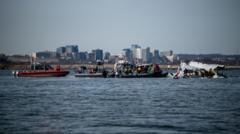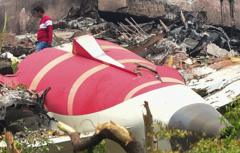Officials from the U.S. government have raised significant concerns regarding air traffic control staffing levels surrounding a tragic mid-air collision in Washington, DC that claimed the lives of 67 people.
Air Traffic Control Concerns Rise After Fatal Washington DC Collision

Air Traffic Control Concerns Rise After Fatal Washington DC Collision
Mid-air crash investigation reveals critical staffing issues at Reagan National Airport.
In the aftermath of the incident, Transportation Secretary Sean Duffy confirmed that the staffing at the Reagan National Airport's control tower was "not normal" at the time of the crash, which involved a military helicopter and a commercial passenger plane. Reports indicate that only one air traffic controller was managing air traffic for both helicopters and planes, a responsibility typically handled by two individuals. During a recent interview on FOX News, Duffy acknowledged these deficiencies, emphasizing the need for a thorough review of standard operating procedures within the Federal Aviation Administration (FAA).
The crash, which occurred on a Wednesday evening, left no survivors among the 64 passengers aboard an American Airlines flight that collided mid-air with an Army Black Hawk helicopter specifically carrying three soldiers. In assessing the incident, Duffy questioned both the time of the helicopter's flight and the appropriateness of having air traffic control operations consolidated at such a critical moment. “Why would they fly a mission at nine o’clock at night through really busy air space?” he asked, advocating for safer flight scheduling.
The National Transportation Safety Board (NTSB) is currently investigating various elements, including the operational altitude of the helicopter—approximately 200 feet, which aligns with the area’s designated flight ceiling for such aircraft. Families of the victims have expressed heartbreak, visiting the tragic sites and honoring lost loved ones.
Additionally, Secretary Duffy highlighted a broader issue concerning chronic understaffing in air traffic control across the nation, noting that over 90% of U.S. facilities are functioning below recommended staffing levels. He acknowledged the immense pressure faced by air traffic controllers and outlined ongoing efforts alongside the FAA to expedite training for new controllers to help alleviate the problem. However, he cautioned that instilling immediate solutions might take considerable time.
As investigators piece together details from the crash, the aviation community awaits answers that may prompt important changes within future operations for enhanced safety.
With significant increases in air traffic and a pressing need for effective operational oversight, the tragic incident serves as a stark reminder of the critical nature of air traffic control staffing in safeguarding lives amidst growing demands on the aviation system.
The crash, which occurred on a Wednesday evening, left no survivors among the 64 passengers aboard an American Airlines flight that collided mid-air with an Army Black Hawk helicopter specifically carrying three soldiers. In assessing the incident, Duffy questioned both the time of the helicopter's flight and the appropriateness of having air traffic control operations consolidated at such a critical moment. “Why would they fly a mission at nine o’clock at night through really busy air space?” he asked, advocating for safer flight scheduling.
The National Transportation Safety Board (NTSB) is currently investigating various elements, including the operational altitude of the helicopter—approximately 200 feet, which aligns with the area’s designated flight ceiling for such aircraft. Families of the victims have expressed heartbreak, visiting the tragic sites and honoring lost loved ones.
Additionally, Secretary Duffy highlighted a broader issue concerning chronic understaffing in air traffic control across the nation, noting that over 90% of U.S. facilities are functioning below recommended staffing levels. He acknowledged the immense pressure faced by air traffic controllers and outlined ongoing efforts alongside the FAA to expedite training for new controllers to help alleviate the problem. However, he cautioned that instilling immediate solutions might take considerable time.
As investigators piece together details from the crash, the aviation community awaits answers that may prompt important changes within future operations for enhanced safety.
With significant increases in air traffic and a pressing need for effective operational oversight, the tragic incident serves as a stark reminder of the critical nature of air traffic control staffing in safeguarding lives amidst growing demands on the aviation system.





















